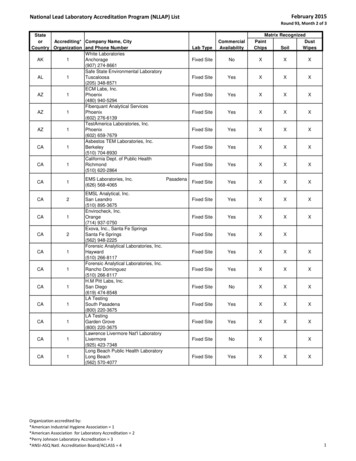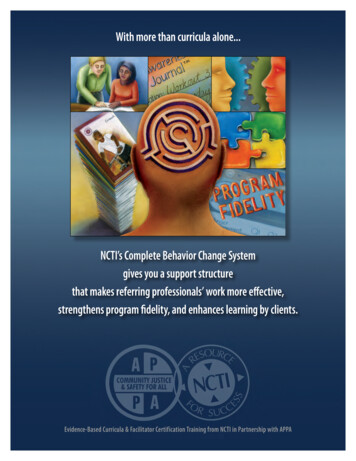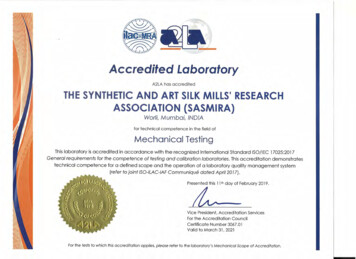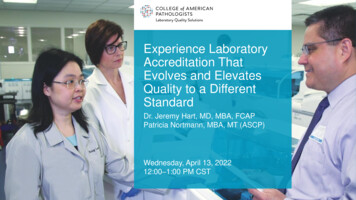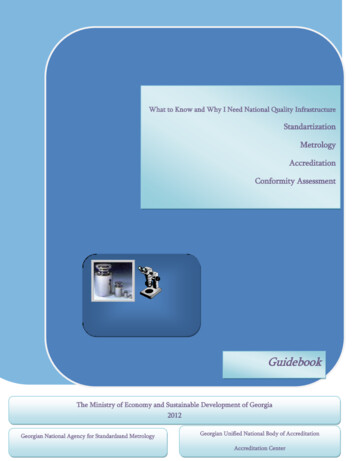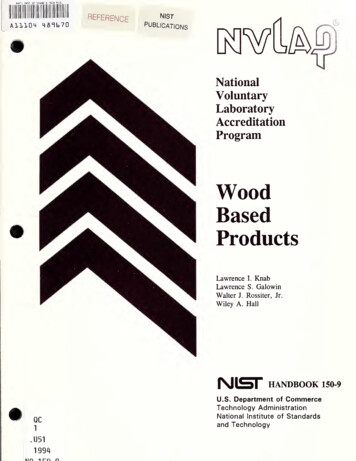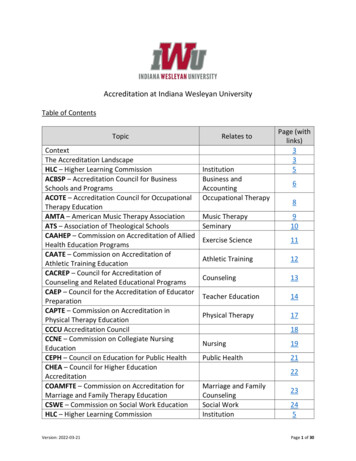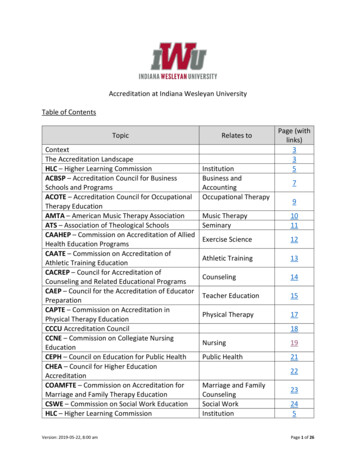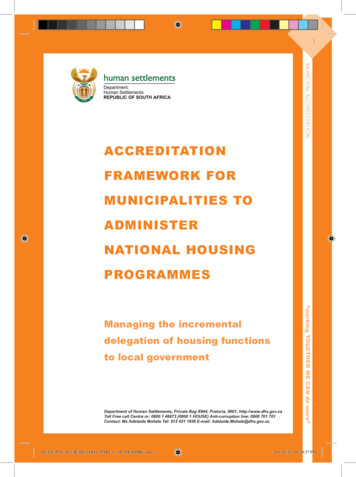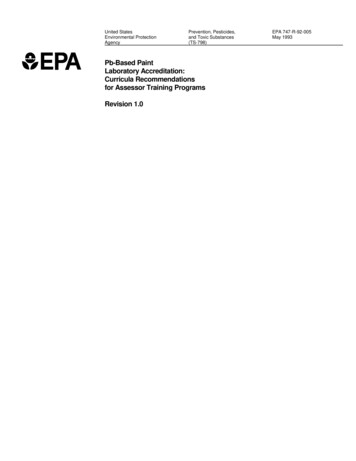
Transcription
United StatesEnvironmental ProtectionAgencyPrevention, Pesticides,and Toxic Substances(TS-798)Pb-Based PaintLaboratory Accreditation:Curricula Recommendationsfor Assessor Training ProgramsRevision 1.0EPA 747-R-92-005May 1993
(BLANK PAGE)
Pb-Based PaintLaboratory Accreditation:Curricula Recommendationsfor Assessor Training ProgramsRevision 1.0Technical Programs BranchOffice of Pollution Prevention and ToxicsU. S. Environmental Protection Agency401 M Street, S.W.Washington, D.C. 20460John V. Scalera, Work Assignment ManagerJanet C. Remmers, Project OfficerMay 14, 1993
DISCLAIMERThis document has been reviewed and approved for publication by theOffice of Prevention, Pesticides, and Toxic Substances, U.S. Environmental Protection Agency. The use of trade names or commercialproducts does not constitute Agency endorsement or recommendation foruse.
NOTICEThis document provides recommendations for site assessor training curricula forassessors of laboratories that analyze Pb in paint film or chips, Pb-based paintcontaminated soils, and deposited dust (vacuum dust and wipe samples). Theserecommendations will form the basis of the training curricula EPA will establish foraccrediting organizations that seek recognition as participants in the EPA NationalLead Laboratory Accreditation Program (NLLAP). Two training course curricula forassessors were developed. The Level One Course is an extensive course of 3 to5 days for the beginning assessor, and the Level Two Course is of 12 hoursduration for the experienced assessor from related fields. Specific lesson plansshould be developed by the accrediting organization, addressing the curricularecommendations presented in this document.
(BLANK PAGE)
AUTHORS AND CONTRIBUTORSMidwest Research Institute (MRI) was requested by the EnvironmentalProtection Agency (EPA) to develop recommended curricula for the training of on-siteassessors. These on-site assessors will perform on-site assessments of laboratoriesseeking accreditation for the analysis of lead (Pb) in paint, soil, and deposited dust,including vacuumed dust and wipe samples, from EPA-recognized accreditationorganizations as part of the EPA National Lead Laboratory Accreditation Program(NLLAP).* These curricula were developed with the cooperation of the TechnicalPrograms Branch, Office of Pollution Prevention and Toxics (OPPT), under EPAContract No. 68-DO-0137. A working meeting was held in Gaithersburg, Maryland,from June 22 to 24, 1992, with a group of metals laboratory accreditation experts togather information for the basis of this report. The affiliations of the working group andthe role of each organization are presented below.MIDWEST RESEARCH INSTITUTE (MRI)MRI was responsible for the planning and the conduct of the working meetingheld in Gaithersburg, Maryland, from June 22 to 24, 1992. Dr. Larry Lowry, who wasthe Work Assignment Leader, had primary responsibility for conducting the meeting andwriting the final reports with input from working group members and Mr. Paul Constant,Dr. Gary Dewalt, and Mr. Jack Balsinger from MRI.WORKING GROUP PARTICIPANTSThe following individuals actively participated in the working meeting and in thereview of this document. Their affiliations and the organizations they represent arelisted. Ms. Harriotte Hurley, C.I.H.Clayton Environmental Consultants1252 Quarry Lane, P.O. Box 9019Pleasanton, CA 94566Chair of the American Industrial Hygiene Association (AIHA)Environmental Lead Laboratory Accreditation Committee (ELLAC).* In order to avoid confusion in the terms lead (for Pb) and lead (for leader), thefollowing conventions are used. Pb will be used for the heavy metal and lead will beused for all other uses. The terms, Auditor, Assessor, and Site Visitor, are usedinterchangeably. The term, Assessor, which is the term preferred by the ISO(International Organization for Standardization), is used in this report. The term, paint,in this document refers to dried paint film or paint chips and not to liquid, uncured paint.v
Larry K. Lowry, Ph.D.Senior Advisor, Exposure AssessmentMidwest Research Institute425 Volker BoulevardKansas City, MO 64110Work Assignment Leader (WAL) and principal author of this report. James Nelson, Ph.D., C.I.H.Director, Data Chem Laboratories960 W. LeVoy Drive, Sorenson Research ParkSalt Lake City, UT 84123An AIHA industrial hygiene laboratory assessor, representing AIHA and DataChem Laboratories. James Pearson, Ph.D. - Division DirectorDivision of Consolidated Laboratory ServicesOne North 14th StreetRichmond, VA 23219Representing the Association of State and Territorial Public HealthLaboratory Directors (ASTPHLD) and state laboratory accrediting organizations.Mr. John V. ScaleraTechnical Programs Branch,Chemical Management Division,Office of Pollution Prevention and ToxicsU.S. Environmental Protection Agency401 M Street SWWashington, DC 20460Work Assignment Manager (WAM) and principal EPA reviewer. James Scott, M.S.Georgia Power CompanyEnvironmental Laboratory5131 Maner RoadSmyrna, GA 30080A lead assessor for the American Association for Laboratory Accreditation(A2LA).vi
Mr. Peter UngerVice PresidentAmerican Association for Laboratory Accreditation656 Quince Orchard Road, No. 304Gaithersburg, MD 20878-1409Vice President, the American Association for Laboratory Accreditation (A2LA). Barbara J. Weaver, C.I.H.Lancaster Laboratories, Inc.2425 New Holland PikeLancaster, PA 17601Represents the laboratory director, Dr. Wilson Hershey, the American Council ofIndependent Laboratories (ACIL) and the Committee on National Accreditation ofEnvironmental Laboratories (CNAEL).EPA, CHEMICAL MANAGEMENT DIVISION, TECHNICAL PROGRAMS BRANCH(CMD/TPB)EPA was responsible for oversight in the development of the study plan;managing and coordinating the conduct of the overall project; and reviewing, editing,and finalizing this report. Key staff included Mr. John Scalera, Work AssignmentManager; Janet C. Remmers, Project Officer; and Dr. Joseph J. Breen, former ProjectOfficer.EXTERNAL REVIEWERSThe following individuals served as external reviewers to this document. Theirparticipation in this review is gratefully acknowledged.Mr. Michael Beard, EPA, Research Triangle Park, NCMr. Albert D. Tholen, NIST, Gaithersburg, MDMs. Regina Bushong, EPA, Washington, DCMr. Fred Grunder, AIHA, Fairfax, VAMr. Frederic Siegelman, EPA, Washington, DCDr. Al Liabastre, U.S. Army, Fort McPherson, GAMay 14, 1993vii
(BLANK PAGE)viii
CONTENTSAuthors and Contributors . . . . . . . . . . . . . . . . . . . . . . . . . . . . . . . . . . . . . . . . . . . . . . vExternal Reviewers . . . . . . . . . . . . . . . . . . . . . . . . . . . . . . . . . . . . . . . . . . . . . . . . . . . viiExecutive Summary . . . . . . . . . . . . . . . . . . . . . . . . . . . . . . . . . . . . . . . . . . . . . . . . . . xi1.2.3.4.5.6.Introduction . . . . . . . . . . . . . . . . . . . . . . . . . . . . . . . . . . . . . . . . . . . . . .1.1Background . . . . . . . . . . . . . . . . . . . . . . . . . . . . . . . . . . .1.2EPA recognition of laboratories . . . . . . . . . . . . . . . . . . . .1.3Purpose . . . . . . . . . . . . . . . . . . . . . . . . . . . . . . . . . . . . . .1.4Approach . . . . . . . . . . . . . . . . . . . . . . . . . . . . . . . . . . . . .Level One Course—The Beginner Course . . . . . . . . . . . . . . . . . . . . . .2.1Course outline . . . . . . . . . . . . . . . . . . . . . . . . . . . . . . . . .2.2Qualifications of assessor candidates . . . . . . . . . . . . . . .2.3Qualifications of course instructors . . . . . . . . . . . . . . . . .2.4Module I. General Overview of theAssessment Process . . . . . . . . . . . . . . . . . . . . . . . . . . . .2.5Module II. Technical Aspects of Pb Samplingand Analysis . . . . . . . . . . . . . . . . . . . . . . . . . . . . . . . . . .2.6Module III. The Assessment Process, orHow to Conduct an Assessment . . . . . . . . . . . . . . . . . . .2.7Module IV. Interpersonal Skills . . . . . . . . . . . . . . . . . . .2.8Module V. Practical Role-playing Exercise . . . . . . . . . .2.9Module VI. Written Examination . . . . . . . . . . . . . . . . . .2.10 Module VII. On-site Internship . . . . . . . . . . . . . . . . . . . .Level Two Course—Update for the Experienced Assessor . . . . . . . . .3.1Course outline . . . . . . . . . . . . . . . . . . . . . . . . . . . . . . . . .3.2Qualifications for admission . . . . . . . . . . . . . . . . . . . . . . .3.3Written examination . . . . . . . . . . . . . . . . . . . . . . . . . . . . .Continuing Education Refresher Course for All Assessors . . . . . . . . . .4.1Objective . . . . . . . . . . . . . . . . . . . . . . . . . . . . . . . . . . . . .4.2Outline of Continuing education program . . . . . . . . . . . .Administrative Issues . . . . . . . . . . . . . . . . . . . . . . . . . . . . . . . . . . . . . .5.1Who offers the courses? . . . . . . . . . . . . . . . . . . . . . . . . .5.2Hiring, use, and dismissal of assessors . . . . . . . . . . . . . .List of References . . . . . . . . . . . . . . . . . . . . . . . . . . . . . . . . . . . . . . . . dicesA.Acronyms and glossary of terms . . . . . . . . . . . . . . . . . . . . . . . . . . . . . A-1B.Assessor checklist for laboratories engages in the analysis of Pbin paint, soils, and deposited dust . . . . . . . . . . . . . . . . . . . . . . . . . . . . B-1ix
(BLANK PAGE)x
EXECUTIVE SUMMARYThe hazards of Pb-based paint have become a leading public health issue of the1990s, and Pb-paint abatement of homes is a high priority among many different healthand environmental organizations. The Environmental Protection Agency (EPA)estimates there are several hundred laboratories, not currently performing analysis, thatwill be involved in new, extensive Pb-abatement programs.Following the lead of the Interagency Lead-Based Paint Task Force (U.S. EPA,1992a), the EPA Office of Pollution Prevention and Toxics (OPPT) is establishing theNational Lead Laboratory Accreditation Program (NLLAP). The NLLAP will providefederal oversight for state and private sector laboratory accreditation programs involvedin the accreditation of laboratories analyzing paint, soil, and dust samples associatedwith the abatement and control of Pb-based paint contaminated housing. The NLLAPwill recognize accrediting organizations that meet EPA minimum requirements througha Memorandum of Understanding (MOU). Each NLLAP-recognized accreditingorganization will administer its laboratory accreditation program under NLLAP oversight.In order to be recognized by the NLLAP, laboratories must meet the following criteria: The laboratory must successfully undergo a systems audit inclusive of anon-site assessment by an analytical laboratory accrediting organizationrecognized by EPA through an MOU. The laboratory must successfully participate in the Environmental LeadProficiency Analytical Testing (ELPAT) program.*The purpose of this document is to recommend criteria for site assessor trainingcurricula for assessors of laboratories that analyze Pb in paint, dust, and soil. Theserecommendations will form the basis of the training curricula that EPA will establish for* The Environmental Lead Proficiency Analytical Testing (ELPAT) Program is acooperative effort to improve and evaluate the performance of laboratories involved in theanalysis of Pb in paint, dust, and soil matrices. The National Institute for Occupational Safetyand Health (NIOSH) performs ELPAT data analysis under a Memorandum of Understanding(MOU No. PW593570-01-0) with the U.S. Environmental Protection Agency (EPA). TheAmerican Industrial Hygiene Association (AIHA) contracts for ELPAT sample production andadministers the ELPAT program as permitted under a Cooperative Research andDevelopment Agreement (CRADA No. NIOSH-92-1) with NIOSH covering cooperation inanalytical research and proficiency test programs.xi
accrediting organizations which seek EPA recognition through an MOU as a part of theNLLAP.These recommendations for site assessor training programs were preparedfollowing a working meeting of experts in metals analysis from government and fromindependent laboratories. Two training course curricula were developed.The Level One Course is an extensive course of 3 to 5 days duration for thebeginning assessor. The course consists of seven modules, including a writtenexamination and an on-site assessment internship. The seven modules cover: (1) ageneral overview of the accreditation process; (2) the technical aspects of Pb samplingand analysis; (3) the assessment process or how to conduct an assessment; (4) theinterpersonal skills needed to conduct an assessment; (5) a practical role-playingexercise; (6) a written examination; and (7) an on-site assessment internship.The Level Two Course is a 12-hour course for the experienced assessor fromqualified NLLAP-recognized accrediting organizations. This course covers threemodules, including modules (1) and (2) from the Level One Course. A writtenexamination is also included. The two courses are designed so that they can be taughtconcurrently.Both courses have minimum education/experience requirements for prospectivestudents and instructors. The courses make extensive use of a checklist that is basedon the ISO Guide 25, the international standard (ISO/IEC Guide 25, 1990). Thecourses should be taught by a team that includes an experienced assessor and anexperienced inorganic chemist familiar with Pb analyses in dust and paint matrices.The two courses are generic in scope and require supplemental instruction onpolicies and procedures specific for individual NLLAP-recognized accreditingorganizations.The NLLAP-recognized accrediting organization will conduct all modules of thecourse. The accrediting organization will certify the assessor and have the option ofhiring the graduates of the program. The NLLAP-recognized accrediting organizationwill also be responsible for monitoring the assessor's performance following completionof the training program and for conducting continuing education programs annually.xii
SECTION 1INTRODUCTION1.1BACKGROUNDThe hazards of Pb-based paint have become a leading public health issue of the1990s, and Pb-paint abatement of homes is a high priority among many different healthand environmental organizations. The Environmental Protection Agency (EPA)estimates there are several hundred laboratories, not currently performing analysis, thatwill be involved in new, extensive Pb-abatement programs.1.2EPA RECOGNITION OF LABORATORIESFollowing the lead of the Interagency Lead-Based Paint Task Force (U.S. EPA,1992a), the EPA Office of Pollution Prevention and Toxics (OPPT) is establishing theNational Lead Laboratory Accreditation Program (NLLAP). The NLLAP will providefederal oversight for state and private sector, laboratory accreditation programsinvolved in the accreditation of laboratories analyzing paint, soil, and dust samplesassociated with the abatement and control of Pb-based paint contaminated housing.The NLLAP will recognize accrediting organizations that meet NLLAP minimum requirements through a Memorandum of Understanding (MOU). Each NLLAP-recognizedaccrediting organization will administer its laboratory accreditation program underNLLAP oversight. In order to be recognized by NLLAP, laboratories must meet thefollowing criteria: The laboratory must successfully undergo a systems audit inclusive of anon-site assessment by an analytical laboratory accrediting organizationrecognized by EPA through an MOU. The laboratory must successfully participate in the Environmental LeadProficiency Analytical Testing (ELPAT) program. (See footnote on page xi.)The completion of a proficiency testing-based program alone is not sufficientproof that a laboratory can perform successfully on real world samples. The proficiencytesting sample, even though it is a matrix-based material, will usually receive specialtreatment in the laboratory. The systems audit is necessary to ensure that a laboratoryhas the required staff, methods, facilities, quality assurance plans, and other essentialsnecessary to perform the analysis within a stated level of confidence.1
1.3PURPOSEThe purpose of this document is to recommend criteria for site assessor trainingcurricula for assessors of laboratories that analyze Pb in paint, dust and soil. Theserecommendations will form the basis of the training curricula that EPA will establish foraccrediting organizations which seek recognition by NLLAP through an MOU.Because of the need to maintain flexibility, this curriculum is intended to be aworking guideline rather than a program outlining specific requirements. At this time,there are no standard EPA-validated analysis methods for Pb in paint, soil, anddeposited dust (including wipe samples and vacuumed samples). In addition, there areno standardized wipe-sampling media. As standardized methods are developed, theywill be incorporated into the training program and replace some of the generic sectionsin the current program.1.4APPROACHCurricula recommendations for site assessor training programs were preparedfollowing a working meeting of experts in metals analysis from government and fromindependent laboratories. Two training course curricula were developed.The Level One Course is an extensive course of 3 to 5 days duration for thebeginning assessor. The minimum qualifications for admission are (1) a B.S. degree inchemistry or related science, (2) a minimum of 3 years nonacademic analyticallaboratory experience, two of which are in metals analysis, (3) documented experiencewith laboratory quality assurance/quality control procedures, and (4) good interpersonalskills. The course consists of seven modules, including a written examination and anon-site assessment internship. The seven modules cover: (1) a general overview ofthe accreditation process; (2) the technical aspects of Pb sampling and analysis; (3) theassessment process or how to conduct an assessment; (4) the interpersonal skillsneeded to conduct an assessment; (5) a practical role-playing exercise; (6) a writtenexamination; and (7) an on-site assessment internship.The Level Two Course is a 12-hour course for the experienced assessor fromqualified NLLAP-recognized accrediting organizations. The qualifications for admissionare (1) the general educational and experience requirements for assessors, asspecified by NLLAP-recognized accrediting organizations, (2) experience in conductingassessments with a minimum of three assessments per year for the most recent 2-yearperiod, and (3) a letter of recommendation from the assessor's accrediting organization.This course covers three modules, including modules (1) and (2) from the Level OneCourse. A written examination is included. The two courses are designed so that theycan be taught concurrently.Both courses have minimum education/experience requirements for prospectivestudents and instructors. The courses make extensive use of a checklist based on theISO Guide 25, the international standard (ISO/IEC Guide 25, 1990). The checklist will2
be provided to the laboratory prior to the site visit for a self-assessment and returned tothe designated assessor. The designated assessor will use the same checklist toperform the on-site assessment. The courses should be taught by a team that includesan experienced assessor and an experienced inorganic chemist familiar with Pbanalyses in dust, soil, and paint matrices. The two courses, which are generic in scope,require supplemental instruction on policies and procedures specific for individualNLLAP-recognized accrediting organizations.The NLLAP-recognized accrediting organization will conduct the final phase ofthe training: the on-site assessment internship. The accrediting organization will certifythe assessor and have the option of hiring the graduates of the program. The NLLAPrecognized accrediting organization will also be responsible for monitoring theassessor's performance following completion of the training program and for conductingcontinuing education programs annually.A continuing education course (refresher course) will be required for allassessors. It would be offered annually and required every two years. It should betaught by the specific NLLAP-recognized accrediting organization and would includeupdates on (1) policies of the NLLAP-recognized accrediting organization, (2)regulations update, (3) health issues associated with Pb, and (4) new technical aspectsof sampling and analysis. The curriculum would be based on case discussions andproblem resolution.The remainder of this document contains the Level One Course (Section 2), theLevel Two Course for the experienced assessor (Section 3), and the continuingeducation module (Section 4). A discussion of various administrative issues is inSection 5. Section 6 gives a list of references. Two appendices include (A) a list ofacronyms and glossary of terms, and (B) the site assessor checklist.3
(BLANK PAGE)4
SECTION 2LEVEL ONE COURSE—THE BEGINNER COURSE2.1COURSE OUTLINEThis beginner course is open to individuals possessing a minimum set ofqualifications as outlined in a variety of publications, including ASTM standard E-994(ASTM E-994, 1990), the Registrar Accreditation Board (1992), the Interagency Leadbased Paint Task Force (U.S. EPA, 1992a), and ISO guides (ISO/IEC 58, 1992). Itruns for 3 to 5 days, depending on the type and number of case studies and thenumber of hands-on classroom exercises used. Qualifications for assessor candidatesare given in Section 2.2. Qualifications for instructors are given in Section 2.3. Thecourse is also open to individuals with an interest in the assessment process, but whohave no interest in becoming qualified assessors. Educational/experience requirements for these "observer" students would be waived, as would be the examination andon-site internship. The major modules of this course are outlined below.2.1.1Module I. General Overview of the Accreditation ProcessThis 2-hour module covers the generic aspects of the accreditation process, thehistory of the health effects of Pb, and the current status of Pb paint abatement issuesand legislation. This section should be taught by a current assessor or individualfamiliar with laboratory accreditation and Pb analysis.An additional 2-hour session is required to acquaint the prospective assessorwith the specific accreditation policies and procedures. This program should be taughtby a representative of the NLLAP-recognized accrediting organization, because theaccreditation process can be expected to be different for each NLLAP-recognizedaccrediting organization.2.1.2Module II. Technical Aspects of Pb Sampling and AnalysisThis 8-hour module, which covers the technical aspects of Pb sampling andanalysis, is aimed at the laboratory chemist. It covers all aspects of laboratory issuesrelated to sampling, analysis, and reporting of data for Pb in paint, soil, and depositeddust matrices. This module should be taught by a chemist with experience in analysesof these matrices for Pb.5
Additional information is incorporated in this module by reference. The EPAreport, "Pb-Based Paint Laboratory Operations Guidelines: Analysis of Pb in Paint,Dust, and Soil," (U.S. EPA, 1992b) describes many of the issues related to samplingand analysis of paint, soil, and deposited dust for Pb from a laboratory perspective. Itcontains specific sections on quality assurance and provides guidance on selection ofdigestion and analysis methods. This EPA report should be utilized in the trainingcurriculum.2.1.3Module III. The Assessment Process, or How to Conduct an AssessmentThis 8-hour module addresses the assessment process and all steps required toperform a successful assessment. Included are pre-assessment steps, the conduct ofthe on-site assessment, reporting requirements, and assessor performance ratings.This section should be taught by an experienced assessor. The following items shouldbe included: Pre-assessment review of documents Pre-assessment communication with the laboratory Preparation for the assessment, including which documents to take Conduct of the on-site assessment to include the following:-Opening conference-Pre-assessment walk through-Use of checklist-Documentation of sample tracking (through use of an audit sample ortracking of samples)-Interviews with key personnel-On-site report writing, as required by the accrediting organization-Closing conference Assessor reporting requirements Assessor performance rating from the laboratory and NLLAP-recognizedaccrediting organization6
2.1.4Module IV. Interpersonal SkillsThis 4-hour module includes the important aspects of how to conduct anassessment and lists of do's and don'ts appropriate for a professional objectiveassessor. This component is possibly the most important module because technicalexpertise is in vain if the assessor does not have good interpersonal skills. This moduleshould be taught by an experienced assessor or an individual knowledgeable in andexperienced with interpersonal skills training.2.1.5Module V. Practical Role-playing ExerciseThis module includes a practical role-playing application of the assessmentprocess. A variety of approaches can be used, such as mock site visits, case studieswith role-playing by students, or video cases with role-playing. The objective is to applyskills learned in the lecture portion of the course. The length of this module can varyfrom a few hours to a full day, depending on the format of the role-playing exercise.This module should be taught by an experienced assessor.2.1.6Module VI. Written ExaminationA 1-hour written examination must be administered to document the successfulcompletion of the course. Guidelines for passing the course were established asdescribed later in this document, along with recommendations for remedial action in theevent of failure. Observer students would not be eligible for the written examination orassessor status.2.1.7Module VII. On-site Internship with a Certified AssessorThis module covers the practical application of the assessment process in anactual laboratory. The recommended criteria include a minimum of two on-site visits,one as an active intern, the second as a primary assessor with the assistance of asupervising assessor from the specific NLLAP-recognized accrediting organization.This module is not part of the generic course and must be administered by an assessorfrom an NLLAP-recognized accrediting organization. Successful completion of the onsite internship should result in certification from an NLLAP-recognized accreditingorganization.2.2QUALIFICATIONS OF ASSESSOR CANDIDATESAssessor candidates should meet the following minimum requirements: A B.S. degree in chemistry or related science. Minimum of 3 years nonacademic analytical laboratory experience, two ofwhich are in metals analysis.7
Documented experience with laboratory quality assurance/quality controlprocedures. Good interpersonal skills.Prospective students who are interested in the assessment process, but do notwish to become assessors, would be admitted as "observer" students. Such studentswould not be eligible for the written examination or any recognized assessor status.2.3QUALIFICATIONS OF COURSE INSTRUCTORSTeam teaching of these courses is most effective because many diverse areasare included in the curriculum. Instructors must meet the requirements for admission tothe Level One course. In addition, they must have experience as current assessors forenvironmental metals laboratories (minimum of three assessments per year for themost recent 2-year period) and familiarity with Pb-analysis techniques and qualityassurance for the specific matrices. Experience with or knowledge of the ISO Guide 25testing laboratory requirements is essential. Instructors who teach interpersonal skillsmay not be required to be assessors or inorganic chemists, provided that they haveknowledge and experience in interpersonal skills training.The initial cadre of instructors may be drawn from current assessors in relatedfields, along with experienced Pb chemists. As the cadre of trained assessors in thisspecific field increases, requirements for instructors may be raised to include successfulcompletion of these courses as a student and demonstrated experience in assessmentwith these Pb-based matrices.2.4MODULE I. GENERAL OVERVIEW OF THE ASSESSMENT PROCESS(4 HOURS)The course objective is to provide the student with an overview of theassessment process, including introductions to the health effects of Pb exposure, thecurrent status of legislation, and issues related to laboratory accreditation.2.4.1Generic Overview Module Applicable to All Assessors and AccreditingOrganizations (2 Hours)The overview module includes generic aspects of Pb laboratory operationsassociated with matrices of paint, soil, and deposited dust, and is applicable to allaccrediting organizations. It includes the following topics: History of government regulatory processes related to Pb and Pb paintlaboratory issues, including discussion of the HUD Guidelines for Pbabatement (HUD, 1990).8
History of health effects of Pb on children and the need for laboratorymeasurements and a laboratory accreditation program. Some discussion ofthe Centers for Disease Control (CDC) statement, "Preventing Lead (Pb)Poisoning in Young Children," should be included (CDC, 1991). General requirements for accreditation as an "NLLAP-recognized"laboratory. 2.4.2-A systems audit inclusive of an on-site assessment by an accreditingorganization recognized by NLLAP.-Participation in the ELPAT program (see footnote xi for explanation).Note: It is not necessary to be accredited by an NLLAP-recognizedaccrediting organization to participate in this program.General requirements of accreditation through an NLLAP-recognizedaccrediting organization based on the ISO Guide 25 (ISO/IE
Vice President, the American Association for Laboratory Accreditation (A2LA). Barbara J. Weaver, C.I.H. Lancaster Laboratories, Inc. 2425 New Holland Pike Lancaster, PA 17601 Represents the laboratory director, Dr. Wilson Hershey, the American Council of Independent Laboratories (ACIL) and the Committee on National Accreditation of
